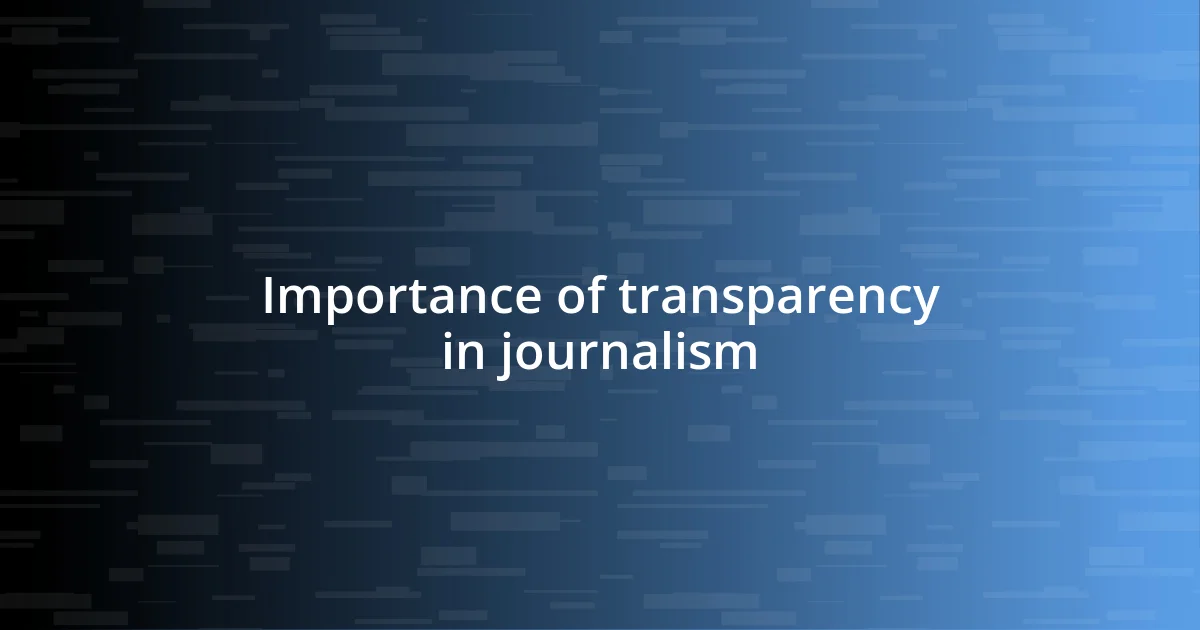Key takeaways:
- Transparency in reporting builds trust and encourages audience engagement by providing clear sources, methodologies, and potential biases.
- Best practices for transparent reporting include clear summaries, detailed citations, and acknowledgment of biases to enhance credibility and connection with readers.
- The future of transparency in journalism will likely involve greater technological integration, real-time data access, and collaborative storytelling between journalists and the public.

Understanding transparency in reporting
Transparency in reporting is essential for building trust with audiences. I remember a time when I encountered a news article that seemed overly polished, lacking the gritty details that grounded the story. It left me feeling uneasy—what were they hiding?
When organizations prioritize transparency, it fosters an environment of accountability and openness. I often think about how much easier it is for me to engage with a source that lays all its cards on the table. Have you ever noticed how a candid report can make complex issues so much clearer?
Moreover, transparency allows readers to better evaluate the credibility of the information presented. I’ve found that when I can see the sources, methods, and any possible biases in a report, it significantly impacts how I perceive the message. Isn’t it interesting how a little transparency can lead to a more informed public dialogue?

Importance of transparency in journalism
Trust is the cornerstone of effective journalism, and transparency plays a pivotal role in establishing that trust. I recall a time when a well-known publication released a story with clear citations and methodology, which made me feel reassured that what I was reading was reliable. It’s remarkable how transparency can transform skepticism into confidence, ultimately encouraging readers to engage more deeply with content.
- Transparency enhances accountability in journalism.
- It allows audiences to scrutinize sources and methods behind stories.
- Transparent reporting helps mitigate the spread of misinformation.
- It promotes a culture of openness that reflects well on the media as a whole.
- Readers are more likely to share and engage with transparent content, fostering dialogue and discussion.
I’ve also observed that when journalists disclose potential conflicts of interest, it significantly influences my perception of their integrity. There was a podcast episode I listened to where the host openly discussed their biases before presenting the news, and it completely shifted my understanding of the narrative. Such honesty deepens the connection between the journalist and the audience, making us feel like active participants in the information-sharing process rather than passive consumers.

Best practices for transparent reporting
When it comes to best practices for transparent reporting, clarity is key. I remember a time when I read a report that began with a straightforward summary of its findings. It made the entire document feel accessible and less daunting. Being upfront about the main points allows readers to quickly grasp the essence, making the report more engaging.
Another crucial aspect is the inclusion of sources. I often find myself more inclined to trust a piece when it features detailed citations. For instance, there was a financial article I followed that linked each claim to its source, which provided a reassuring layer of validation. This practice not only enriches the report but also empowers readers to explore further if they choose.
Lastly, acknowledging potential biases can significantly enhance transparency. I came across a documentary where the filmmakers candidly explained their perspective, admitting their own leanings throughout. This openness encouraged me to trust their portrayal of events, as I felt they were committed to honesty rather than crafting a one-sided narrative. This simple acknowledgment creates a connection with the audience, making them more receptive to the information shared.
| Best Practice | Description |
|---|---|
| Clear Summaries | Present main findings up front for easy understanding. |
| Include Sources | Provide detailed citations to enhance trust and validity. |
| Acknowledge Biases | Discuss any potential biases to foster openness and connection. |

Challenges of maintaining transparency
Maintaining transparency in reporting can be a daunting task. I find that one of the biggest challenges is the constant balancing act between providing sufficient detail and keeping content concise. Have you ever read an article where the author seemed to overload you with technical jargon? It can be overwhelming. I believe that clear communication without sacrificing depth is essential; however, many journalists struggle to achieve this delicate equilibrium, leading to potential misunderstandings among readers.
Another hurdle is the fear of backlash from sources or stakeholders. There’s often a worry that being too transparent might compromise relationships. I experienced this firsthand during a project where we had to decide whether to disclose certain expert opinions that were outside the mainstream. It was a tough choice—should we risk alienating collaborated voices for the sake of honesty? This dilemma can lead to cautious reporting, ultimately hindering the level of transparency that builds audience trust.
Lastly, time constraints often clash with the desire for full transparency. In today’s fast-paced media landscape, I’ve seen many reporters rush to publish their stories to stay relevant. I once noticed how a news piece that lacked sufficient background details ended up spreading misinformation, causing confusion among readers. This rush to be first can lead to overlooking crucial elements that ensure transparency. It’s a tough reality, but I think it’s a reminder that integrity shouldn’t be compromised for immediacy in reporting.

Tools for enhancing reporting transparency
One effective tool for enhancing reporting transparency is the use of interactive infographics. I remember encountering an interactive chart in a health report that allowed me to explore data trends over time. It wasn’t just a static image; I could hover over specific points to get more details. This feature made complex information more digestible and engaging. Have you ever seen a data visualization that completely shifted your understanding of a topic? I know I have, and it truly highlights how visuals can bridge the gap between raw numbers and meaningful insights.
Another valuable resource is transparency platforms, like data repositories, which offer access to raw data from reports. I stumbled upon one such site while researching environmental impact studies. By diving into the raw data, I could cross-reference findings and form my own conclusions. It felt empowering to sift through the information instead of just accepting the presented narrative. Isn’t it refreshing to have the tools to dig deeper? These platforms not only bolster trust but also encourage a more informed dialogue around the subject matter.
Finally, fostering a culture of feedback can significantly improve transparency in reporting. I’ve participated in several workshops where feedback sessions were emphasized, allowing reporters to refine their work based on audience insights. I often left those sessions feeling more connected to my readers, knowing their perspectives helped shape my writing. Isn’t it wonderful to think that a single comment can lead to a more transparent and engaging piece? Inviting feedback not only enhances clarity but also helps build a community around shared knowledge and experience.

Case studies of transparent reporting
One notable case study of transparent reporting comes from ProPublica, which is renowned for its commitment to thorough investigative journalism. I recall reading a piece about the impact of a city’s budget cuts on public services. The team included not just their findings but also detailed methodologies, including interviews and public documents. It made me feel like I was part of their journey to uncover the truth. Have you ever felt empowered by fully transparent reporting like that? It really can change how you engage with a story.
Another excellent example is the BBC’s approach during the COVID-19 pandemic. They dedicated a section of their website to publishing updates and raw data about the pandemic’s spread and government responses. I found it reassuring to navigate through their interactive maps and charts, which presented clear, concise information on a complex situation. It struck me how vital transparency was during such uncertain times—didn’t it for you, too? Their efforts not only informed but also built trust within the community.
Then there’s the case of The New York Times using transparency in its editorials. I distinctly remember an editorial where they openly shared their reasoning behind the recommendations for public policy changes. It was refreshing to see how they laid bare their thought process, making it clearer how they arrived at their conclusions. Don’t you think that such openness can foster a better understanding and acceptance of even contentious issues? It’s this kind of candidness that can lead to healthier discourse in society.

Future of transparency in reporting
While I think about the future of transparency in reporting, I envision a landscape where technology continues to play a pivotal role. Imagine a world where everyone has access to real-time data and reporting tools right at their fingertips. Personally, I’ve always been fascinated by how quickly news spreads today, and with advancements in AI and machine learning, it wouldn’t surprise me if we start seeing news articles tailored to reflect various perspectives based on user preferences. How cool would that be?
Moreover, I believe that trust will be at the forefront of journalistic integrity. As we move forward, transparency will not just be a nice-to-have; it will become essential. I often find myself wondering how much more skeptical audiences will become. It seems to me that every misstep by a journalist or a news outlet will be scrutinized. In such a climate, those who openly share their sources and methodologies will likely stand out. It’s a concept I believe will encourage deeper connections between reporters and their communities.
Looking ahead, I envision a shift in the relationship between the public and journalists. People will not only consume news but also participate in its creation. I can recall a community forum I attended where local residents contributed their thoughts on issues plaguing our neighborhood. Imagine if similar initiatives were commonplace in reporting—how enriching would it be to co-create narratives that represent diverse voices? This collaborative approach could redefine transparency, turning it into a shared endeavor that fosters trust and understanding in society.














